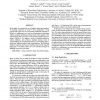Free Online Productivity Tools
i2Speak
i2Symbol
i2OCR
iTex2Img
iWeb2Print
iWeb2Shot
i2Type
iPdf2Split
iPdf2Merge
i2Bopomofo
i2Arabic
i2Style
i2Image
i2PDF
iLatex2Rtf
Sci2ools
105
Voted
ISBI
2008
IEEE
2008
IEEE
Investigating implicit shape representations for alignment of livers from serial CT examinations
In this paper, we examine the use of implicit shape representations for nonrigid registration of serial CT liver examinations. Using ground truth in the form of corresponding landmarks manually labeled by a radiotherapist, we carry out an experiment to determine whether nonrigid registration performs better when applied to the original image data or to images constructed from implicit representations of the liver. We compare a variety of standard regularizers (elastic, diffusion, and curvature), similarity measures (sum of squared differences and mutual information), and weighting factors, using three different implicit shape representations: the Euclidean Distance Transform, the Poisson Transform (based on the expected hitting time of a random walk), and a new transform designed to highlight concavities in the shape.
CT Liver Examinations | Implicit Representations | Implicit Shape Representations | ISBI 2008 | Medical Imaging |
| Added | 20 Nov 2009 |
| Updated | 20 Nov 2009 |
| Type | Conference |
| Year | 2008 |
| Where | ISBI |
| Authors | Nathan D. Cahill, Grace Vesom, Lena Gorelick, Joanne Brady, J. Alison Noble, J. Michael Brady |
Comments (0)

